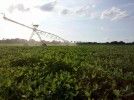|

| Adrian,
We use proline in furrow in addition to an insecticide for thrips but the pro-line is pretty pricey. We have done a few strip trials on farm and you can generally see a visible difference in the crop on treated vs. untreated. Im not entirely sure of the economic side of things if peanuts are cheap? Its hard to put a figure on lbs/acre of peanuts gained.
If you wanted I have heard of a post emergent applications 3-4 weeks after planting with 40GPA banded over the row offers great control of white mold also. Supposedly you get more control of CBR from the in-furrow application.
Proline is very similar to Provost so you may want to follow with a non triazole type fungicide sometime throughout the year. And according to the info below its safe to use with inoculants so you should be good to go there.
I found some info from UFL and posted below
**************
Early season white mold control. Although “60 days after planting” remains our standard recommended date to begin the “white mold/soilborne” phase of our fungicide program on peanuts, there is no doubt that there are seasons, e.g., 2010 and 2011, when it is prudent to start the program earlier. Work over the past two years has documented the opportunity to better manage a serious white mold problem by banding a FULL broadcast rate of Proline (5.7 fl oz/A) in a narrow band directly over the young peanut plants 2-5 weeks after planting. The exact timing of the application for optimum white mold control may vary from season to season; e.g. in 2011 control of white mold improved as the time of application was delayed from 2 to 5 weeks after planting. I would recommend that most growers consider the timing of an early-emergence application to be between 3 and 4 weeks after planting, recognizing that in some years even a little later can be beneficial. In a study last season, Dr. Tim Brenneman achieved similar results in control using spray volumes of 40 gal/A and 10 gal/A. Bayer CropScience recommends 20 gal/A for the early emergence application. The early emergence application of Proline offers growers the opportunity for a good start on white mold control and, based upon a trial from 2011 in Colquitt County, Rhizoctonia limb rot control. The use of Proline early in the season is followed by an effective white mold fungicide program at the appropriate time later in the season. Growers looking for early season white mold control, but choosing not to use a Proline program, may consider the option to include tebuconazole in one or both of the first applications (30 and 45 days after planting) tank-mixed with chlorothalonil, Headline or other appropriate leaf spot material, so long as appropriate considerations are given to fungicide resistance management in the later soilborne fungicide program.
5. Management of Cylindrocladium black rot (CBR). For growers who anticipate problems in their field (or fields) from CBR, our basic management program remains as follows. First, try not to plant peanuts following peanuts or soybeans. Second, consider fumigation of the field with Vapam or metam sodium at 10 gal/A. Third, if you do not use Vapam or metam sodium, we strongly advise that you apply Proline, 5.7 fl oz/A in-furrow at planting. Note: Proline can be safely mixed with Rhizobium inoculants. Fourth, consider planting the peanut cultivar Georgia Greener which has some documented resistance to CBR. Fifth, follow up with a fungicide program that includes Abound, Headline, Provost, or other fungicide labeled for the suppression of CBR.
| |
|


 Peanuts. Fungicide in furrow?
Peanuts. Fungicide in furrow?